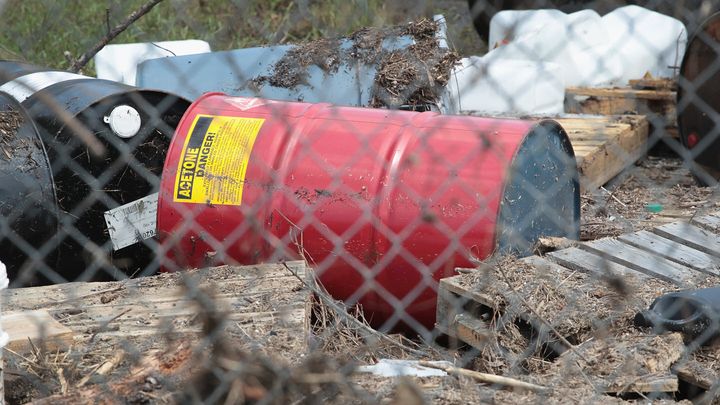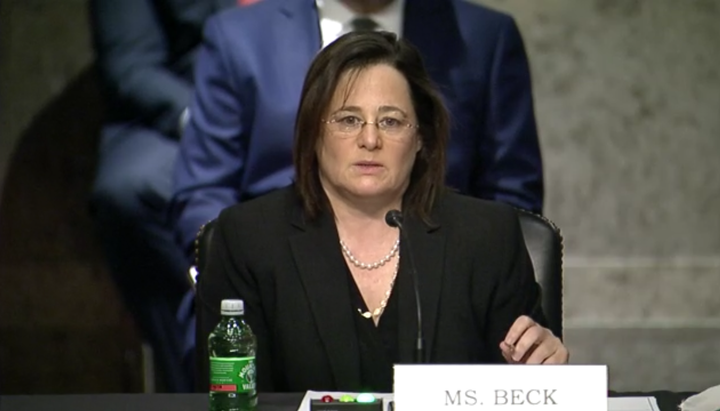In 2017, the Trump administration sided with industry lobbyists and rescinded safety rules governing thousands of chemical plants across America. Five years later — after multiple chemical plant explosions in the Houston area — government investigators are telling lawmakers that a lack of federal regulation is heightening the risk of chemical disasters during climate change-related extreme weather events at thousands of facilities nationwide.
President Joe Biden’s administration is considering issuing a new rule regulating such facilities — but not until next summer. Chemical companies and industry groups have already sicced their lobbyists on the EPA to stop the new rules, arguing that, despite all evidence to the contrary, their members are well-prepared for disasters and will only be made more vulnerable by new regulations.
Last week, the Government Accountability Office (GAO), a watchdog agency, published a report warning that nearly one-third of commercial and industrial facilities that make, use, handle, or store hazardous chemicals are located in areas vulnerable to natural hazards like flooding, storm surges, and wildfires that are likely to be worsened by climate change.
Under the 1990 Clean Air Act, the Risk Management Plan (RMP) rule requires facilities that use hazardous substances to develop plans that identify potential effects of a chemical accident, lay out prevention steps, and spell out emergency responses. While these RMP facilities are directed to assess all possible causes of emergencies, the GAO report found that climate-related risks were not being factored in, leaving facilities with insufficient information and direction on threats like hurricanes and sea level rise.
More than 3,200 of the 10,420 RMP facilities across the nation, including chemical manufacturers and water treatment plants, are at risk of releasing toxic chemicals into the environment due to natural hazards that will be exacerbated by the warming climate, according to the GAO study.
Thousands of facilities are located in areas considered at high risk for flooding, with hundreds in areas that may be inundated by storm surge or with high wildfire hazard potential. The report found that more than 150 facilities, especially in the Gulf Coast, are located in areas that may become subject to at least one foot of sea level rise — and that the risk of flooding at high tide is already present in the vast majority of them, 133 facilities.
“The GAO report itself is good, though like most government reports, it understates the threat in bureaucratese,” said Kevin Bell, an environmental attorney with the nonprofit Public Employees for Environmental Responsibility, who has challenged the EPA in court. “A major winter storm or hurricane exacerbated by climate change can knock out power to dozens or hundreds of facilities storing who knows what kinds of chemicals. What it does not do is describe in relatable terms what that means: a rolling fog of who-knows-which mystery chemicals that can travel for miles before dissipating.”
The GAO’s report largely corroborates a July 2021 report from environmental groups the Center for Progressive Reform, Earthjustice, and Union of Concerned Scientists that found that nearly 4,000 facilities like oil refineries and industrial agricultural facilities face enhanced risks of climate-fueled natural disasters because of their potential exposure to sea level rise, flooding, and forest fires.
“These risks are not prospective — we’re talking about present-day natural hazard risks, and the analyses from both reports are actually pretty conservative, based on the data we have and the methodologies designed,” said David Flores, senior policy advisor at the D.C.-based Center for Progressive Reform.
Killing Obama-Era Safety Rules
The chemical industry, one of the most powerful lobbying forces in the United States, has long fought government efforts to protect the public against hazardous substance leaks due to climate-related disasters or other types of incidents.
Following a 2013 explosion at a Texas fertilizer plant that was blamed in part on a lack of federal regulations on how some dangerous chemicals must be stored, the Obama administration directed the EPA and other agencies to review whether risk management planning regulations should be expanded.
The review culminated in the EPA publishing a major update to RMP rules during the final days of the Obama administration that proposed requiring tens of thousands of industrial facilities to assess their potential chemical release impacts and take steps to prevent such incidents. The update proposed requiring some companies to submit to third-party compliance audits, consider deploying safer technologies, and to make information available upon request to the public regarding what kinds of chemicals they store, accident history information, and their emergency response plans.
The rulemaking faced intense opposition from the chemical industry — more than 44,000 comments were filed by chemical company lobbyists, trade associations, and others. With the Trump administration and a Republican Congress taking power in January 2017, the industry had powerful allies to help them stop the new rules from taking effect.
Oklahoma Republicans Sen. Jim Inhofe and Rep. Markwayne Mullin proposed resolutions early in the 2017 congressional session to block the Obama rules that were immediately celebrated by chemical and oil interests. The industries’ major trade groups, the American Fuel and Petrochemical Manufacturers and the American Chemistry Council (ACC), posted statements in support of the resolutions, making familiar arguments like how the regulations would increase companies’ compliance costs and that the public information requirements could create security vulnerabilities. In an op-ed posted at The Hill, ACC president and CEO Cal Dooley, a former member of Congress and a founder of the New Democrat Coalition, wrote that information required by the regulations “could be used to plan and execute dangerous and potentially deadly attacks on chemical facilities.”
Inhofe is the fifth-highest career recipient of oil and gas industry money among current senators, and he has received nearly $265,000 from the chemical and related manufacturing industry. In the 2018 election cycle, he received PAC donations from chemical industry groups including ACC, DuPont, 3M, and LyondellBasell Industries. Mullin’s top career donor industry is oil and gas, according to OpenSecrets, and he has received more than $50,000 from the chemical and related manufacturing industry.
In June 2017, EPA administrator Scott Pruitt delayed the new regulations for 20 months, and then in November 2019 the administration pushed through a severely weakened version of the rule, stripping out the requirement that companies disclose their chemicals, no longer requiring them to consider using safer technologies or procedures, and removing the condition that companies face independent audits after incidents in which chemicals were accidentally released.
Last month, the Biden administration included in its regulatory agenda plans for a new EPA rule to improve RMP regulations. The plans are part of the administration’s Protecting Public Health and the Environment and Restoring Science To Tackle the Climate Crisis executive order, which calls on agencies to take actions to bolster resilience against the impacts of climate change. The new rules are slated to be finalized in August 2023.
A String Of Industrial Explosions
Recent years have seen a string of disasters at chemical and oil refinery plants, many in the Gulf Coast region, which is subject to flooding and hurricanes that are likely to increase both in frequency and intensity.
In December, an explosion at ExxonMobil’s Baytown refinery in Texas, one of the largest refineries in the U.S., severely injured several people and sent smoke spewing after a spark ignited flammable gas, according to a lawsuit by two contract workers. The same facility had three fires in a months-long stretch of 2019. The first, in March, released toxic pollutants for eight days after being extinguished, according to Harris County officials. A July fire resulted in injuries to dozens of people. Later that year, a chemical plant explosion in Port Neches, Texas injured three, and in 2020 an industrial explosion in Houston killed two people, also destroying nearby homes.
During Hurricane Harvey in 2017, explosions at a Houston-area plant owned by French company Arkema spewed smoke from chemical fires after flooding and a power blackout. The year before, Arkema had submitted a comment to the EPA rulemaking criticizing its plans to strengthen chemical plant safety rules and joined its trade group ACC’s lobbying push, successfully blocking them from taking effect.
A Lobbying Force
The chemical industry’s influence efforts over regulations are led by the ACC, a trade association of hundreds of member companies and an annual budget of more than $120 million, according to its recent tax filings. The ACC was the tenth-highest spender on federal lobbying in 2021, according to OpenSecrets, at over $16.6 million. The group’s lobbying spending in 2021 jumped from the year before, when it spent $14 million, and the ACC has consistently disclosed lobbying on risk management planning rules going back a decade.
In a regulatory comment responding to the Biden administration’s initiative to update chemical facilities’ climate safeguards, ACC wrote that systemic changes are not needed and that current RMP rules already require companies to plan for severe weather events. Instead, the ACC says a better approach would include providing additional compliance assistance.
Dozens of ACC’s lobbyists are revolving-door figures who previously worked in government, according to records maintained on OpenSecrets. Joshua Baca, vice president of ACC’s Plastics Division, is a former House staffer and National Coalitions Director for Mitt Romney’s presidential campaign. ACC lobbyist and vice president of federal affairs Ross Eisenberg previously spent time at the National Association of Manufacturers, as policy counsel at the U.S. Chamber of Commerce, and as an environmental litigator at the corporate law firm Greenberg Traurig LLP.
Chemical giant Dow has regularly lobbied the EPA on rules for RMP facilities from 2016 to 2019, according to a review of Senate records. The company’s 2020 trade association membership disclosure lists dues paid to the ACC, the American Fuel & Petrochemical Association, the American Petroleum Association, the U.S. Chamber of Commerce, and the Chamber’s legal advocacy group. Dow was among the large corporate donors to the Biden inaugural committee, giving $250,000 according to year-end filings for 2020, double the amounts that came from Anthem and Verizon.
AFPM wrote in a July 2021 comment to the EPA that, “a more reasonable approach is to emphasize case-specific oversight of facilities that are performing poorly, instead of imposing costly regulations that are unlikely to improve overall safety performance.” It also said that the EPA should not subject facilities to new security vulnerabilities by requiring more information sharing.
The U.S. Chamber of Commerce for years has lobbied regarding “risk management” as related to the Clean Air Act, including in the first quarter under the Biden administration on the issue of “Potential rulemaking on risk management procedures under Section 6(a) of the 2016 revisions to the Toxic Substances and Control Act (TSCA),” spending totals in the tens of millions of dollars every quarter.
Weighing in on the proposed rules changes in July, the Chamber warned of “the potential risks involved with sharing information too broadly,” invoking cyberattacks, preferring instead a performance-based approach to regulation that it says will “allow for businesses to innovate and find the most effective means of solving problems.”
“The chemical industry has almost complete control of EPA,” said Bell at Public Employees for Environmental Responsibility. Bell sees the new GAO report as a wake-up to the EPA’s downplaying of extreme weather hazards, differentiating climate-related disasters from accidents or mechanical failures.
Donations To Key Members Of Congress
The chemical and related manufacturing industry has donated at least $6 million to congressional incumbents in each election cycle going back to 2007-2008, and it focuses its donations on key members of Congress with seats on subcommittees that oversee large parts of chemical policy.
Senate Committee on Environment and Public Works Chair Sen. Tom Carper (D-Del.) has received almost $543,000 from the chemical industry over his career, including nearly $29,000 in the current election cycle, making him the second-highest recipient from the industry among senators. The committee’s ranking member, Sen. Shelly Moore Capito (R-W.V.), has received more than $350,000 from the industry, including close to $18,000 this cycle.
On the Chemical Safety, Waste Management, Environmental Justice, and Regulatory Oversight Subcommittee, which has jurisdiction over chemical policy and the EPA’s pollution control office, ranking member Sen. Roger Wicker of Mississippi has received nearly $173,000 from the chemical industry.
House Energy and Commerce Committee Chair Rep. Frank Pallone (D-N.J.) has received more than $272,000 in campaign donations from chemicals and related manufacturers. The second-most senior Republican on the committee, Rep. Frank Upton of Michigan, has raked in more from the chemical industry than any other current House member at more than $470,000, placing him in the top ten of all House members. Ranking member Rep. Cathy McMorris Rodgers (R-Wash.) has over $120,00 in industry contributions. She is likely to become the committee’s chair if Republicans take control of the House in 2023.
On the Environment & Climate Change Subcommittee, whose jurisdiction includes the EPA, toxic substances, and the Chemical Review Board, the industry’s PACs and employees have consistently donated to ranking member Rep. David McKinley (R-W.Va.), totaling more than $175,000.
According to Bell, ACC’s lobbying will likely complicate the EPA rulemaking process ahead. “The aim will be to minimize costs to industry for as long as possible, weaken any proposed rule, delay implementation, and cast the entire effort in the media as a wasteful government burden,” he said.



